#mitchell riopelle
Explore tagged Tumblr posts
Text
Ça aurait pu être un film
Une artiste mondialement célèbre, un compagnon qui l'est moins et son amante américaine quasiment inconnue. Autour de ce trio, Martine Delvaux enquête dans le but de réaliser un film. Il en résultera l'un des romans les plus originaux de cette rentrée !
En deux mots L’idée de réaliser un film sur trois artistes, Joan Mitchell, Hollis Jeffcoat et Jean Paul Riopelle va séduire Martine Delvaux. La romancière va enquêter pendant plusieurs années pour ce projet. Ce livre est le fruit de ses recherches et réflexions. Ma note ★★★ (bien aimé) Ma chronique Joan, Hollis, Jean Paul et Martine Une artiste mondialement célèbre, un compagnon qui l’est moins…

View On WordPress
#Amour#Art#artiste#écriture#Beaux-arts#Biographie#biopic#célébrité#Enquête#exposition#film#Hollis Jeffcoat#Jean Paul Riopelle#Joan Mitchell#Paris#Passion#Peinture#quête#scénario#synopsis#vie de couple
0 notes
Text
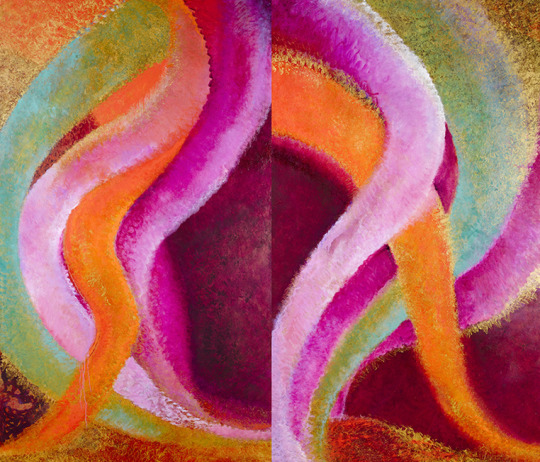

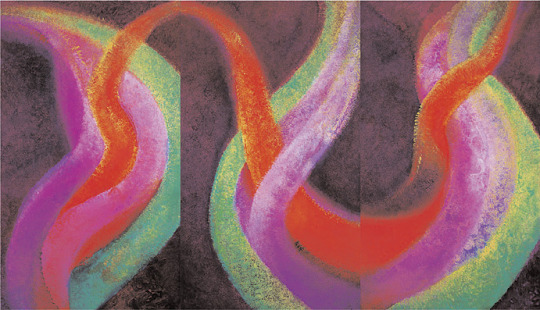
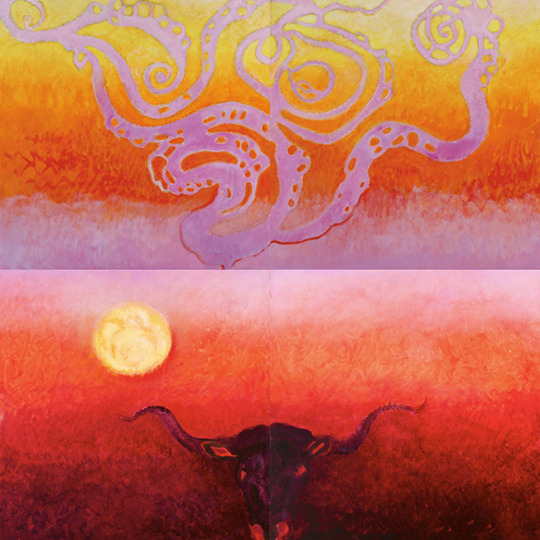
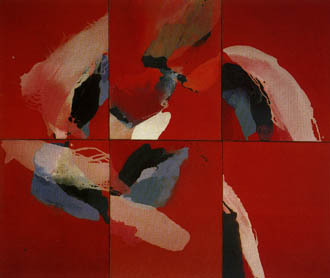
Anne Madden is particularly well known in both Ireland and France where she has divided her time for the past forty years. Of Irish and Anglo-Chilean origin, Anne Madden spent her first years in Chile. Her parents returned to Europe to live in Ireland and in London, where she subsequently attended the Chelsea School of Arts and Crafts. During this period she was impressed by an important exhibition of American painting at the Royal Academy. It was Abstract Expressionism that opened up new possibilities of experimentation for her at that time. She later met some of these artists in Paris and New York among them Jean-Paul Riopelle, Joan Mitchell, Mark Rothko, Lee Krasner and others with some of whom she exchanged works. The techniques employed included palette knife and paint flows and soon involved the use of multiple canvases as a means of creating pictorial interactions.
She began to exhibit in group shows in London and Dublin from the age of 18. The Burren and her love of wilderness informed these early paintings. Her work was then interrupted for three years by a series of operations on her spine. During that time she met the painter Louis le Brocquy who was then working in London. They married in 1958 and set up house and studio in the south of France, where two sons were born to them, Alexis and Pierre.
From the mid sixties on their comparatively reclusive life in Carros village was changed by the opening of the Fondation Maeght in Saint-Paul, where over the years they were constantly meeting painters, sculptors, writers, poets, and musicians forming friendships resumed in Paris and elsewhere. In 1965 Anne Madden represented Ireland at the Paris Biennale, before regularly exhibiting in that city. From the 1960s she began to pour paint onto the canvas making a series of abstract landscapes influenced by her time as a young girl in the west of Ireland, near the Burren in Co Clare. Between 1970 and 1979 she embarked on a large series of vertical works, their size determined by her height and reach. Reflecting on life and death, the works derived from megaliths and other prehistoric monuments seen in the Burren were elegiac in nature. In the 1980s Madden stopped painting for a time and devoted herself to drawing. This resulted in a series of large works in graphite and oil paint on paper entitled Openings, which formed the exhibition of her work at the Fondation Maeght, in 1983 and represented her in ROSC '84.
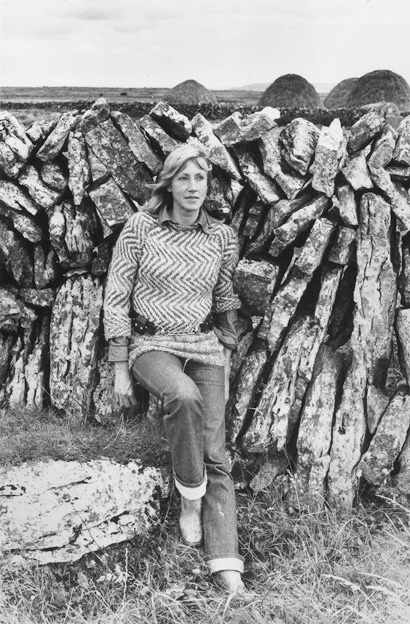
12 notes
·
View notes
Text
Cappelle Calling - Singer-songwriters - 25 november 2024

Deze maandag was het 50 jaar geleden dat de ondergewaardeerde Britse singer-songwriter Nick Drake overleed. Om die reden stonden alle drie zijn albums centraal als LP van de Week, en was dit een speciale singer-songwriter uitzending van Cappelle Calling. Met daarin verzoekjes van luisteraars voor singer-songwriters.
Terugluisteren kan hier.
Dit was de playlist:
Uur 1:
David Gray - Babylon Zach Bryan - This World's A Giant Carole King - (You Make Me Feel Like) A Natural Woman Nick Drake - Time Has Told Me (LP van de Week) Al Stewart - Small Fruit Song Shawn Mullins - Anchored In You Bill Withers - Grandma's Hands Mike Lindsay & Guy Garvey - Saturday Sun (DisCovered) Tracy Chapman - Talkin' Bout A Revolution Elliott Smith - Angel In The Snow (Filmplaat - uit 'Up In The Air') Ben Howard - I Forget Where We Were Townes Van Zandt - Waiting Around To Die Bob Dylan - Don't Think Twice, It's Alright Nick Drake - Riverman (LP van de Week)
Uur 2:
Harry Chapin - Cats In The Cradle Kacey Musgraves - Cardinal Nick Drake - Day Is Done (LP van de Week) Joni Mitchell - A Case Of You Nick Drake - Saturday Sun (DisCovered) Judy Blank - Mary Jane Dave Loggins - Please Come To Boston Nick Drake - Northern Sky (LP van de Week) Jerry Riopelle - So Young Michael Kiwanuka - The Rest Of Me Nick Drake - Pink Moon John Martyn - Solid Air Glen Hansard & Markéta Irglová - Falling Slowly
Cappelle Calling is iedere maandagavond van 20:00 t/m 22:00 te horen op Radio 90FM. Iedere woensdagmiddag wordt de uitzending herhaald van 18:00 tot 20:00. Ook wordt het programma op vrijdagavond van 20:00 t/m 22:00 uitgezonden op Slotstad Radio, waar het op zondagavond van 22:00 t/m 22:00 wordt herhaald. Suggesties voor DisCovered of De Filmplaat zijn welkom via de Facebookpagina van het programma of via [email protected].
#cappelle calling#playlist#filmplaat#radio 90fm#regio90#lp van de week#90fm#slotstad rtv#slotstad radio
0 notes
Text
Volume XIII: The Orozco Collection: Abstract
Karel Appel, Pierre Alechinsky, Enrico Baj, Alan Davie, Jim Dine, Oyvind Fahlstrom, Sam Francis, Robert Indiana, Antonio Saura, Alfred Jensen, Asger Jorn, Allan Kaprow, Alfred Leslie, Andy Warhol, Roy Lichtenstein, Mel Ramos, Joan Mitchell, Kiki O.K., Claes Oldenburg, Robert Rauschenberg, Reinhoud, Jean-Paul Riopelle, James Rosenquist, Kimber Smith, K.R.H., Sonderberg, Walasse Ting, Bram Van…

View On WordPress
0 notes
Text
Perroquet vert / Sans titre / Piroche / Iceberg n°5 / Iceberg n°3 / hommage à Rosa Luxembourg

Le Perroquet vert, 1949, huile sur toile, 110,2 x 140 cm – Musée du Québec, Québec, Canada – Catalogue raisonné de Jean Paul Riopelle, tome 1, pp. 277 et 369
Iceberg n°5
Tes titres figurent, ils figurent et orientent Iceberg Noir Tes titres orientent Perroquet vert, je ne peux que le voir Ton perroquet vert dans l’amas ocre, rouge, marron, vert, caca d’oie, Dans l’amas ocre, sable, sienne, perroquet, caca d’oie, jonquille, brun, Sanguine, sapin, prusse, vert-jaune, sable, vermillon Dans l’amas o�� le blanc perce neige reflet et dessine Dessine le, les perroquets verts qui dans la jungle Dans le sombre de la jungle capte la lumière rai reflète Dans quelle jungle, vert vert bois, dans quel zoo, dans quelle merde Où se cachent perroquet, sa symphonie Est-ce la symphonie du cacquètement Qu’à la surface craquelée j’entends C’est perroquet l’exotisme de quel Lieu De quel temps Je pense à tes grues Riopelle A tes oiseaux, à ta Rosa, A quel exotisme ton Perroquet vert Picassien ou braquois Répond-il, depuis quel langage Quel apprentissage de quelle répétition ? Figure-t-il Figures-tu Te figures-tu
from / to vert / Rosa
Figure-t-il Figures-tu Te figures-tu Iceberg Noir Pour à toi parvenir Dans le blanc, le blanc Qui à la surface Au dessus Ne cessera de s’ajouter Le blanc s’ajoute Comme ponctue Avant d’advenir De tout recouvrir Qu’enfin le blanc existe Et qu’au blanc la couleur Ne fasse que le faire Ressortir Sors De tout temps l’éclat de la neige Qui fond Et tient traduit Quel langage Quelle langue Quelles traces Mystiques
Les monstres des bords blancs des cartes
Au bord tout au bord des cartes Quand inconnu Quand le territoire était inconnu Pas exploré mais désiré La carte était laissée blanche - telle Mise en scène de Claude Ollier - là où le problème des cartes est toujours celui - des envahisseurs Et dans les bords blancs apparaissaient Des monstres Car au bord des mondes Gardent les mondes de L’interpénétration des mondes Les monstres

Photo: Archives Yseult Riopelle, Sans titre, 1964. Huile sur toile, 130 × 160 cm
Trait d’union (3)
De Riopelle-Mitchelle Je comprends que le trait d’union est pour toi le blanc Iceberg Noir Pas la toile, le blanc, la toile seule griffure peut l’atteindre C’est le combat pour faire apparaître la neige Telle qu’elle source dans les toiles de Mitchell Alors de la matière que faire, car la matière Iceberg Noir chez toi est couleur Du blanc, du blanc que faire, de la peinture De la matière peinture blanche avalanche que faire De l’épaisseur du matériau, de ton travail au couteau C’est à l’aveugle retrouver le tracé, la trace, le trait, la figuration, Sous la neige le trait d’union
Danse dans la neige, 1948 Françoise Sullivan
De la danse de Mitchell sur les toiles Riopelle vient, en 1948 a, était Avec Sullivan, Françoise Sullivan Qui ses danse des qures saisons créait Riopelle et Maurice Perron Pour Danse dans la neige Sur le Mont Saint Hilaire Où l’invite Riopelle à danser A la suivre filmer photographier Yseult a deux mois, Françoise Riopelle la tient dans ses bras De la danse de Sullivan à celle de Mitchell Pas à pas de la danse sur neige glacée à l’apprêt plat de la toile Pour, Riopelle, à la neige Nécessaire de revenir Nécessaire de revenir à Saint-Hilaire Dix ans après, Mitchell pour invitée Et Y tracer, Piroche, Y tracer signes Empreintes Dansés dans ses yeux Si souvent

Piroche, 1976, huile sur toile, 203,3 x 549 cm, quadriptyque – Université de Sherbrooke, Sherbrooke, Québec, Canada

Iceberg n° 5, 1977, huile sur toile, 200 x 260 cm
Iceberg n°1
un iceberg c’est blanc, et bleu, et transparent, et gris et
immense
Iceberg n°2
je comprends sans comprendre l’absence de couleur la série presque tout en noir et blanc quand je ressens la couleur c’est dès la lumière pas le soleil la lumière dès que les nuages se déplacent jour ou nuit soleil lune ou étoiles quand le soleil ne redevient qu’une étoile comme une autre absente
Iceberg n°3
cette toile c’est Robert le diable à l’envers pour les couleurs et le blanc pas la technique ou alors la technique à l’envers serait de faire miroiter les coup de couteau carrés le bocage l’étroitesse à l’espace dont les règles sont celles physiques et toujours spirituelles de la répétition qui se compose à la composition qui organise le geste
Iceberg n°4
De la nuit noire J’ai ce souvenir enfant Dans le Vercors Dans le Vercors enneigé gelé Dns le Vercors avec Une dizaine d’enfants Et mon grand-père Qui se perd nous perd Nous avons skié toute la journée Et dans la nuit noire sommes rentrés C’est-à-dire Dans la nuit d’un plateau où les nuages Cachaient de la nuit toute lumière Dans la nuit de nos yeux de toute la journée Fatigués de la neige Blanche ou grise, marron et verte Transparente et jaune Une branche de sapin sous la neige l’irise Il y a ce blanc très particulier de la neige tassée Et toutes ces couleurs que les sensations procurent D’une neige légère qui tombe et grise Sur les paupières les joues Devient rouge la neige brûlure De celle qui glisse sous les patins fartés Et wootche wootche wootche De celle qui a fondu regelé fondu Où se posent fleurs flocons qui nuit tombe se laissent prendre intactes sous des mètres encore visibles Celle où trop sont passés bouillie Celle brillante de reflets Il y a l’eau grumeuleuse Il y a de la neige mon amour
Extrait de Maîtresse-Cherokees de Josée Yvon (une Mitchell canadienne telle que j’imagine que Riopelle aurait pu la rêver)
Impossible. Mitchell ne meurt pas. Elle est de celles qui n'ont rien à perdre, noire évasive d'actes fous, sincères mais dangereux.Mitchell est descendue de la Baie James, sept ans de travail parcimonieux dans un «office» d'une LG2 paralysée, sans bouger, elle attendait, elle était amoureuse. Au printemps du désespoir, les hommes ont changé de camps. La peur l'a accablée très vite. Où est-il cet amant qui l'avait volée? Personne. Elle tremble malade de bière dans le bureau hurlant. Elle a reviré le pupitre sur le nom des gars qu'elle devait dactylographier. Un désert dans ce camp élucidé. Rien... Elle a empoigné la petite dans la main droite, son «mickey» dans la poche gauche. Su' le pouce, pas de bagages, ça dépendrait des lifts... Couchées dans un lit ou sur le bord d'un ruisseau. Est-ce que ça s'appelle un pays? Quinze jours le long du lac à l'Ourse. Se laver sans faire de bruit dans toute la splendeur des cris de forêt, Donna serrée qui halète plus fort que les hululements. Elle lui raconte que tous les moutons blancs sur les vagues douces cahotent bien moins violents que sa petite écume tassée en cris embrasés de désir déferlant. Elles buvaient dans la rivière glacée, jusqu'à ce qu'un vieux garde-chasse surgisse, comme le vieillard à la lanterne... Elles ont fui dans les sous-bois d'un silence consentant, éperdues, des milles jusqu'à l'éclaircie, une petite route de terre... On se rend toujours où l'on focuse aller. «I left a woman waiting». Entra dans la première brasserie, la petite n'est pas servie, elle dort anyway. Une chambre à louer au-dessus de la taverne, couche la petite et redescend boire jusqu'à la fermeture.

Iceberg n°3, 1977
Rosa critique
L'indépendance de la pensée est pour nous de la plus haute importance. Or, elle ne sera possible que si, abstraction faite de toute calomnie. de tout mensonge, de toute injure, nous accueillons avec gratitude et sans distinction de tendance, les opinions exprimées par des gens qui peuvent se tromper, mais qui n'ont en vue que le salut de notre Parti. Je ne parle pas pour moi, mais d'une façon générale : c'est avec joie qu'on devrait accueillir des idées nouvelles puisqu'elles rafraîchissent un peu le répertoire suranné, routinier de notre propagande.
Rosa Luxembourg, Liberté de la critique et de la science, 1899

L'hommage à Rosa Luxemburg (détail)

L'hommage à Rosa Luxemburg (détail), 1992. Acrylique et peinture en aérosol sur toile , 155 x 1 424 cm (1er élément); 155 x 1 247 cm (2e élément); 155 x 1 368 cm (3e élément), Coll. MNBAQ. Don de l'artiste.
Oiseaux-Blancs
Les grues blanches De ton Hommage à Soleil Rose, Iceberg Noir, Ces grues blanches Ce sont autant d’iles Qui reflètent négatives Les toiles de la rue Frémicourt C’est le blanc ceint Le blanc-seing Que t’aurais enfin donné Mourant Soleil Rose Tu couronnes le blanc Du corps des grues Elle-même D’un halo noir Tout le blanc enfin revenu Au centre du centre Dans le corps vivant D’oiseaux coureurs Et élastiques Ce blanc cet hommage C’est tiré les coins des tableaux Que tu as aimé d’elle Faire un nœud à ton mouchoir Ne jamais l’oublier C’est le blanc qui cesse de t’envahir neige C’est ce qui de toi fond d’elle, Soleil Rose qui s’auréole et que tu peins Iceberg Noir
#mitchell riopelle#mitchell riopelle un couple dans la démesure#jean-paul riopelle#joan mitchell#un couple dans la démesure#iceberg n°5#iceberg n°3#perroquet vert#hommage à rosa luxembourg#rosa luxembourg#josée yvon#maîtresse cherokee#Liberté de la critique et de la science#fhel#landerneau#prolongations#poésie critique#kawala#piroche#danse dans la neige#françoise sullivan#sans titre#monstres#bord des cartes#blanc dans la peinture
0 notes
Photo

Jean-Paul Riopelle / Joan Mitchell
35 notes
·
View notes
Photo



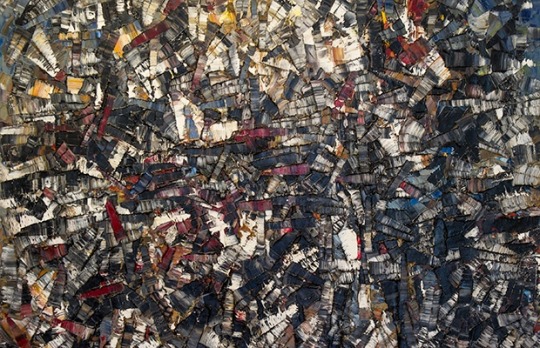


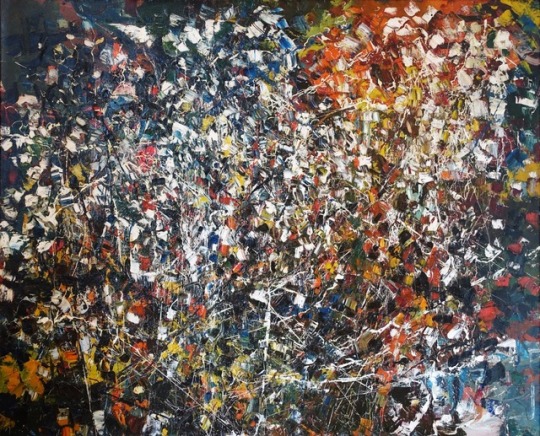

NON-AMERICAN POSTWAR ART VIII
JEAN-PAUL RIOPELLE
In the late 1940s and ‘50s, québécois painter Jean-Paul Riopelle took part in many of the rebrandings of the European art world, which had been disrupted by the war and then displaced by what Irving Sandler has called “the triumph of American painting.”
Riopelle’s conception of art as the unconscious rendered in abstract forms through the agonistic confrontation with the canvas perfectly mirrors the uneasy cohabitation of lingering indigenous Surrealism and emergent Action Painting à l’américaine in the École de Paris.
Riopelle’s art also participates in another major strain of that catch-all movement, which might be called Post-Post Impressionism. What began in the early 1950s the outright imitation of Jackson Pollock’s direct application of paint from the tube on to the canvas transformed into heavy impastos applied by palette knife in serried rows of hatchmarks–Cézanne crossed with Van Gogh, or a glamourous. extroverted Nicolas de Staël.
New York School refugee Joan Mitchell showed Riopelle the way past Abstract Expressionism. Living next door to Giverny, both ex-patriates profited from prolonged proximity to the Nymphéas.
NON-AMERICAN POSTWAR ART SERIES: I: Pierre Soulages II. Renato Guttuso III. Guiseppe Capogrossi IV: Nicolas de Staël V: Paolo Scheggi VI: Takeo Yamaguchi VII: Serge Poliakoff
6 notes
·
View notes
Photo

Paris, 1963. Le couple Joan Mitchell et Jean-Paul Riopelle dans le séjour de l’atelier-appartement de la rue Frémicourt.
Photo : Heidi Meister
9 notes
·
View notes
Photo

Mes Nympheas, 33, Joelle Kem Lika
To paint water lilies in 2015 ?? I have been longing to meet Claude Monet for a long time, by this dialogue between painters that has been going on for... a long time... Monet has created this work of art surprising by the modernity of its volume, Monet as the precursor to monumental art works, but also by the way he shaped his increasingly abstract flowers, the harmony of the colours... the choice to abandon the structuring logics of landscape painting... announcing impressionism. Realism and abstraction... In his time, Monet used to dialogue with Jongkind, Bourdin, his elders... And also Courbet, Manet... Courbet used to hate idealism. « Because the ideal, according to him, is far poorer, far less vast, far less mysterious than reality. » (text by Yvon Taillandier in his book : Monet) My search between abstract and figurative-realism has led me to create an accessible kind of abstraction, full of possibilities, thanks to a little figurative «key», inspired by the realism of a water lily... Monet has inspired a whole generation of painters such as Jackson Pollock, Joan Mitchell, Jean Paul Riopelle, Sam Francis. Each one of them moves me, profoundly... I love Pollock’s work, the freedom of his movement, his will to exceed the limits of the frame, Riopelle and his overlapping colours a contemporary vibration and impressionism, Mitchell and her completely abstract paintings, so full of vivid colours... the pure abstraction of Sam Francis, and Jenkins... When contemporary art is recognized by its provocative quality, I want to take a different path that leads, not to construction, structuring, nor to destruction or destructuring, but to feeling our « pulse of life », in our bodies, reconnect this inner source. To feel the link between the beauty of nature, the strength of the living energy, and our lives, our bodies,. A planet like a big body, a common emotion and sensuality. With these paintings, I would like to draw the viewer towards the beauty of real nature, magnificent and so close, all the time, in every context, ocean, forest, field, flowers, rivers, mountains... that needs nothing else but a benevolent and admiring eye. I enjoy approaching the theme of these flowers, in my work with trowels, knives, and other tools created for the occasion... my search for matter effects... of transparencies, light... I have worked with a harmony of colours composed of blues, yellows, greens, turquoises, violets, contemporary and gay, lively... close to Nature. And played with the reflections, the shadows. I love to start off with the beauty of Nature, real, and to let inspiration come to me... an inner vision, that guides my movements. My work on water lilies has procured me great pleasure : to create abstract paintings, and to open a gate to a whole imaginary world... Are we in a blue jungle, on a river bank, a lake... under trees and reflections of the sun... ??? Surprised at first, every viewer travels as he pleases and remains contemplative, calm, peaceful, joyous... The meaning I want to give to my paintings... : to testify of the threatened beauty of our planet… We can generate a new world, new relationships… a new consciousness of being, in order to change the vicious circle of destruction in which we are… I believe there is a whole part of humanity who want to fight to save our planet, and to build in stead of destroying... I have been surprised to read the following in the dictionary of symbols : « A big lotus brought out of the essential waters is the cradle of the sun in the first morning. Opening their corolla at dawn and closing it in the evening, the white water lilies, to the Egyptians, concretized the birth of the world from the wet. » In India, water lilies also represent the beauty of Life, searching the light of the sun, born in the rich mud at the bottom of the water... Even if we wade in the mud of our human meanders, we can feel the richness of our pulse of life, in the bottom of our hearts, and choose to live it, to express it, to let it get the upper hand over our death pulse... Surviving... is exhausting, and doesn’t lead any where... I choose to paint the pulse of life, Eros rather than Thanatos... I would like my water lilies to tempt people who contemplate them to dive into peace, beauty, and so finding a kind of resource of natural tenderness and strength, this pulse of life that is present inside all of us, in each flower, each grain of sand, each drop of water, for what we need to do : to reveal ourselves alive, and change every thing. To abandon constraints, to believe in Life... to believe in the butterfly effect, there are already many people on earth who believe in Life... and fight for Life... I love to believe that we can create a force of Life... stronger than anything else.
https://www.saatchiart.com/art/Painting-Mes-Nympheas-33/718590/3257592/view
3 notes
·
View notes
Photo










Monet et l’abstraction
Monet and abstraction
Thierry Dufrêne, Jacques Taddéi, Paloma Alarco, Michel Draguet
Hazan, Paris 2010, 175 pages, ISBN 9782754104791
euro 40,00
email if you want to buy [email protected]
L'héritage de Monet continue de susciter de nouveaux rapprochements et son influence auprès des peintres abstraits de la seconde moitié du XXe siècle est, depuis quelques années, l'objet de nombreuses recherches. Cette exposition poursuit ce travail de réflexion et propose un face à face de quelque 44 tableaux impressionnistes et abstraits. Le parcours s'attache à mettre en lumière les résonances de l'oeuvre de Monet avec celles des peintres abstraits : #Pollock, #Rothko, #Hofmann, #Gottlieb, #Vicente, #Riopelle, #Krasner, #Tobey, Still, #Francis, #Mitchell, #Zao Wou-ki, etc. Au milieu du XXe siècle, la « redécouverte » de Monet à travers la matérialité de sa peinture, sa technique « all-over », ses touches vives et ses formes estompées sont une véritable révélation pour la jeune génération de l'abstraction américaine, mais aussi pour les adeptes des « informalismes » européens. Paris, Musée Marmottan, 16 juin-26 septembre 2010
21/04/20
orders to: [email protected]
ordini a: [email protected]
twitter:@fashionbooksmi
instagram: fashionbooksmilano, designbooksmilano tumblr: fashionbooksmilano, designbooksmilano
#Monet#Claude Monet#abstraction#art exhibition catalogue#Musée Marmottan#peintres abstraits#all-over#fashion inspirations#fashionbooksmilano
4 notes
·
View notes
Photo

Joan Mitchell (1925 Chicago, USA - 1992 Paris, FR)
Untitled, c.1955
Oil on canvas, private collection
MITCHELL | RIOPELLE Un couple dans la démesure
16 décembre 2018 au 22 avril 2019
Fonds Hélène & Édouard Leclerc, Landerneau
Photo : Helene Aupee 03/2019
#art#modern art#abstract expressionism#painting#joan mitchell#american artists#oil on canvas#exhibition#fonds hélène et édouard leclerc#landerneau#france
1 note
·
View note
Photo

#Repost @matchwithart La rencontre de deux grands à la @fondationlv. Le lien entre Joan Mitchell et Claude Monet m’était familier grâce au musée de l’Orangerie, où une oeuvre de l’artiste américaine vous attend à la descente des escaliers. Cette exposition met face à face deux artistes à l'expression artistique différente mais dont les palettes de couleurs se rejoignent parfaitement. Il y en a pour tous les goûts, ceux qui aiment la douceur de Claude Monet, avec des oeuvres qui n’ont pas été vues depuis un siècle en France ; la découverte d’une autre Joan Mitchell, avec des tableaux recouverts de matière et de couleur où le blanc n’a plus sa place. Pour ce premier match, place à Mitchell. Alors qu’elle construit sa carrière d’artiste à Chicago, Joan Mitchell découvre la peinture européenne, Claude Monet, Vincent Van Gogh, des peintres de la nature, aux paysages figuratifs. Elle se familiarise plus tard, à New York, avec des artistes comme Willem de Kooning, Jackson Pollock dont l’art est plus abstrait, expressif. Elle est une artiste reconnue et expose déjà régulièrement ses oeuvres. En 1955, à Paris, elle rencontre le peintre canadien Jean-Paul Riopelle, qui devient son compagnon jusqu'en 1979, et partage sa vie entre notre capitale et New York avant de venir s’installer en France. Ses oeuvres commencent à porter les noms lyriques de « Tilleul », « un jardin pour Audrey », montrant que son inspiration est désormais la nature. Mais elle ne veut pas la représenter telle qu’elle la voit, mais telle qu’elle la ressent, se basant sur ses souvenirs plutôt que sur la réalité déclarant « Je préférerais laisser la nature où elle est. Elle est assez belle comme ça. ». C'est naturellement que l'artiste se rapproche de sa source d'inspiration en s'installant à Vétheuil, un village situé près de Giverny... Joan Mitchell Beauvais, 1986 Exposition « Claude Monet – Joan Mitchell, dialogue » à la Fondation Louis Vuitton jusqu’au 27 février 2023 ———————————————————————— Avec le soutien de l’école de management de l’art et de la culture @icart_officiel ———————————————————————— #fondationlv #fondationlouisvuitton #claudemonet #monet #joanmitchell #MonetMitchell @joanmitchellfdn https://www.instagram.com/p/CjuSP3YI_xu/?igshid=NGJjMDIxMWI=
1 note
·
View note
Text
Artist Interview #1 - Jérôme Nadeau
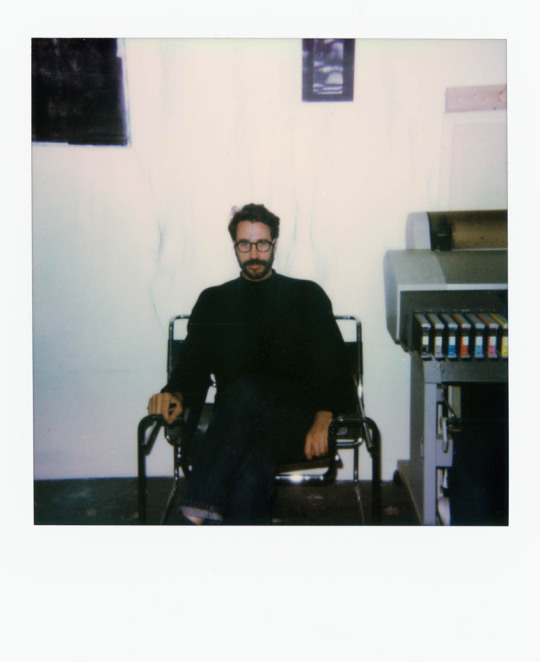
William: So for redundancy's sake just I guess introduce yourself and the basic gist of what you’re interested in your work.
Jérôme: Yeah so I’m originally from Levis, which is across the river from Quebec City. And I moved to Montreal about 10 years ago to go to Concordia in Photography. I did my undergrad there and I did an MFA there that I finished two years ago. I also studied during my MFA in Gothenburg in Sweden. While doing my MFA I also a thing called Soon.TW which is a publishing house and then two years ago when I finished my MFA we actually turned the project into a contemporary art gallery which is right there. And at this point we decided to take over this space and turn it into an actual physical space. I was joined by two artists Jean-François Lauda and Nicolas Lachance, and then at some point in the process there’s Simon who joined us. Simon was in Chicago doing his MFA, we also studied together we did our undergrad together and then he moved to the United-States and came back. So we started that project. In my practice I’m interested in photography and like I said before, mostly in the process of photography so what’s usually left unseen from the photographic process. Exploiting photography for what it is. Kind of a challenging indexical link with reality.
William: Did you start your art experience with photography or?
Jérôme: No I actually started, well in Cegep I studied film-making and by the end of that I realized I was never going to do that. I’m still really interested in cinema and yeah I still think it’s the most amazing medium in the way that it has this kind of capacity to attract mass media even with very kind of-
William: Artistic?
Jérôme: Yeah artistic aesthetic or philosophical kind of questions and it’s something that goes beyond any other medium which I think is interesting but it’s this thing where you have to collaborate with many people and I don’t know… I’m not a fan of that industry which is something that is always a long process to be able to achieve that and I saw that coming quite early. I mean what you need to do to be able to make it I guess in this world. At this point I finished studying filmmaking and then I went travelling to Australia. And I was like should I buy a video camera or a photo camera and it was kind of at the beginning of digital photography being kind of affordable so I bought this digital camera for a few hundred dollars which is now completely obsolete. I’ve kind of learned to photograph through that, like there was a manual mode and I started to kind of experiment with it and I really-
William: So then you learned photography digitally before eventually going back to analog?
Jérôme: Yeah exactly but again I was at this point interested in abstraction. I remember the portfolio I submitted for Concordia for the undergrad was a lot of like longer exposure and colourfield photographs and it was all not necessarily very straightforward and I was also very interested in painting but I have absolutely no talent in painting and no patience to…
William: To get better?
Jérôme : To get better and I’ve never been formally trained as a painter so I like I remember as a teenage kind of, like in the backyard making this huge kind of Riopelle painting. Like I had a lot of fun with the process of painting but just, yeah I was lacking this kind of training that would allow me to get better. Or be able to actually do-
William: Like take something from your mind and put it onto the canvas?
Jérôme: Exactly, exactly. It felt like it was really limited but I was very interested in painting and I remember I had an art history class and I was interested actually with Canadian painting. Painters like Riopelle and stuff like that. I remember Riopelle because he died on this island called Isle-aux-Grues which is not too far from Quebec city, it’s in the middle of the river and my mom’s cousin has a house there so yeah I just remember seeing his work and at the National Museum in Quebec (city) and being kind of… really transported by his practice. I never really had a contact with art growing up like my family was just more involved in sports and stuff like that. So I remember walking into that museum and just kind of, I don’t know, really amazed by that painting. You know what I was saying about cinema? Like I kinda found a little bit of that in his work you know so I was just feeling stuff and is that even possible? Like you can’t really understand that from just reading about it or having a slide lecture in Cegep about it. So I was kind of mystified by that in a way but then again it was such on a large scale so this understanding of materiality that was kind of beyond me.
William: So do you think that experience informed your future work?
Jérôme: Oh yeah it informed the rest of my life. Like I remember that moment and they still have that painting in a permanent collection and I go back almost every year to see it. And there was this big show he did at the end of his life called the: “L’hommage à Rosa Luxemburg” because he had this relation with Joan Mitchell, the American painter, and when she passed he started this 120 meter long painting that’s an homage to her and it was shown in its entirety. It was bought by the museum now so it’s on permanent view and last year they actually made a show of Joan Mitchell and Riopelle too which was kind of interesting. So yeah I grew up with that-
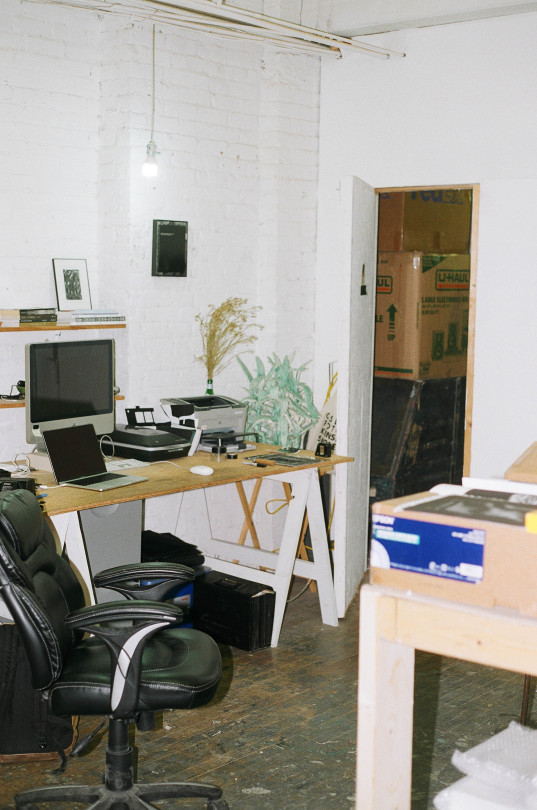
Wanda: How young were you when you saw it?
Jérôme: I was in High School when I saw that for the first time so it just stuck with me and this kind of part of my life life where I started being more aware of like… culture in general but at this point there was internet but it was harder to find independent movies and even in Quebec city to find this kind of more edgier stuff.
William: And yeah especially in Levis too.
Jérôme: But a young age I started working in Quebec and getting involved in music a lot too. The electronic music scene was kind of beginning so I started being involved a little with film-making and a lot with music at this point. So you know I started making music, producing music, it was the beginning of what they call laptop techno. So you were moving on from vinyl and actually the programs like Live just came out and so it was quite easy to make music in your bedroom.
William: Do you think music still informs your work in some way?
Jérôme: Yeah, yeah totally. I mean not necessarily in terms of production because when I moved to Australia there was this, I don’t know, it’s still pretty expensive to buy records and just kind of constantly invest in all of that so I decided to travel and I started focusing on photography and when I came back I applied for Concordia while I was away and I got back and moved directly to Montreal to study. So I already made my choice to pursue visual arts and that music was not going to be a number one priority but its always been there. Like I’ve DJ’d for the past 15 years as a side job so I think it’s more this aspect that informs my work. Well not that it informs it but I feel that-
William: Do you work with music? Like in your space?
Jérôme: Oh yeah I listen to music all the time like if I don’t have my headphones there’s a good chance I’m not going to the studio. I know that there’s a lot of artists that can’t work with music but with me it’s just the opposite.
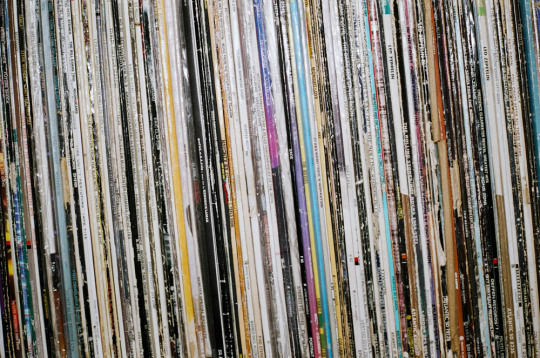
William: I kind of feel the same way when I do any sort of series I make a playlist specifically for it and I only listen to it when I working on it.
Jérôme: Yeah, sometimes I’m not even listening like I know, I don’t do it here as much but when I was doing my MFA I had a studio in a basement of the VA so there was no signal whatsoever so I could listen just to the same song over and over. It’s just you know especially physically when I’m working you don’t really listen to it. And there’s this thing where I feel, not with painting but with working even just on the computer, where you really get in the zone of something. Like it just feels like a different state of mind and there’s a lot of exterior signals that can be blocked out. But I just feel that music is just filling this weird void and it just allows me to focus. But sometimes you know if I do more quiet operation I listen just to white noise but I need something-
William: So you just essentially need noise?
Jérôme: Yeah
William: Does it, like are you looking for a mood or just a feeling while working or?
Jérôme: Hmm not necessarily I mean it informs what I’m listening to. But yeah it just gives me this form of energy. Especially when I’m working with headphones, it feels like I’m really blocking out the exterior and allows me to go deeper with my thoughts and with what I’m doing. That’s the only thing that’s happening is what I’m doing right now which is nice.
Wanda: If you’re in the space by yourself, do you ever listen to the music with no earphones?
Jérôme: No, no, then I get scared because someone would walk in and I’m just there with my headphones playing super loud.
William: Yeah I can only work with headphones too, I think it’s the physical part of having something in your ear that help block out those signals that you were talking about.
Jérôme: And when I’m writing I can’t really listen to any music, it has to just be sound. Or I have earplugs too sometimes. So I think it has something to do with my ear, maybe they need to be blocked.

Wanda: How do you see yourself or express yourself through your work?
Jérôme: To kind of go back to what I was saying with music and cinema then photography. I started at Concordia and the first thing we’re doing in the 210 class, you start working in the darkroom. Then I got really absorbed by the process of it. Like being in the darkroom. Especially starting with a digital camera where you take an image and then you put it on the computer screen you don’t really question it. It just appears there and it’s kind of magical but you don’t really see it as a physical thing. Then working in the darkroom and learning the basic of the film and I was really interested in the colour theory and physics behind photography. The mistakes that would happen in the darkroom too because there was a lot obviously. But I feel like something that informed my work up until now is following what messed up and try to accentuate it and always playing. I feel like the more I learned about the process of photography the more I could dismantle it. To just focus on certain specific areas of the photographic process.
So I guess what I’m trying to achieve… it’s a really hard question. It’s not that I don’t think I have anything to say. I just feel we feel in really complex times. Specially medium specificity and setting up these things it’s the process of photography that’s speaking for itself it’s not necessarily me. It’s funny because it’s always what I’ve been interested in, just the process, physics, and theory. And someone once mentioned to me it’s also a way of hiding any sort of personal expression from the work which could or could not be seen as a reflection of my personality. But coming from that person it really stayed with me. It’s what really motivated me a while later to introduce the writing in the actual work. So it’s a way to make something about the process a bit more personal through poetry and through self-expression that I feel a strong connection through poetry and visual abstraction. I feel that it’s functioning the same way. Obviously one is more visual than the other one but I feel the end process in your brain is quite similar and I thought it was a way to do that. And obviously even that isn’t really straightforward but for me there’s a connection to an event or a moment or person, something like that. It could be reflective, even if it’s abstract. I can look back at older work, me having produced that, it’s a moment in your life and it transports you to where you were. But for everyone else it’s not possible to achieve that. So I feel that leaving little clues can make that happen.
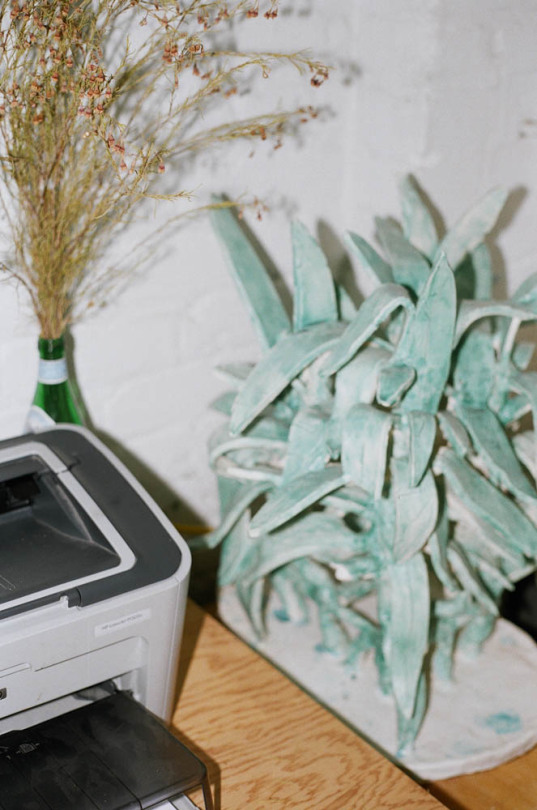
William: When did you realize you needed to have a studio space? And when you were trying to find a studio what were you considering? Did the image in your mind translate into reality?
Jérôme: I’ve always wanted a studio space. I was hanging around painters and I mean I had a studio in my apartment for awhile. I lived with a roommate and we had this huge apartment so I took the dining room and made it my studio. But at some point I was working with chemicals so I had to work outside and it just wasn’t convenient to do that in your own house. But I mean I was obviously restricted by budget and when I started the MFA I was pretty excited because you have a studio. Then I realized in photography you don’t really have a studio it’s an office on the same floor as where the labs are so I was pretty disappointed. But I started working in the spray painting room and using that but everything was scattered and always at school so it didn’t really make sense to have an outside studio at this point. When I moved to Sweden I was told it was the same thing that in this program you have this huge studio and some people even lived in it but when I moved there they decided to transfer me into the photography program and the photography program only had offices too so I was like are you kidding me. But they found me a little place in the basement where I could work and I came to Concordia and I applied for a studio in the VA which is more of a traditional space. I could do anything, and I really liked it. It was really small. Maybe half the size of here, no windows, I would just close the door-
William: And it was kind of like the earplugs?
Jérôme: Exactly. I could just close the door, no computer, it was just work. So I feel it was a really productive time. Then after your second year of your MFA you don’t have access to a studio anymore so you still have access to the facilities but you don’t have a physical space that’s assigned to you. So during that summer, my friend Étienne was subletting from Alexy and was going to Glasgow. So it was a last minute thing. I was working and I asked him what are you doing with your studio when you’re leaving? And he didn’t know so I was like ok I’m going to sublet it from you. So I worked here for that whole summer. It was while he was gone that the lease was transferred through Vincent. And Vincent asked if I wanted to stay since we’re doing this photography based studio and I said yes. Étienne came back and for a few months I was in a corner and we decided to share the space for that time.
Wanda: You’ve had studios with other people and by yourself, do you think you express yourself differently when you’re sharing a studio versus when you have a space to yourself? Also do you think it shows in your work?
Jérôme: Yeah totally. Now that you’re saying that I’m thinking that I had another studio for a few months in that building on Van Horne & Parc but it was before they renovated it. My friend he had a studio there for a year but the studio was maybe as big as both our studios here. There were like six people there And he had this big table and he’s doing collage… but I never actually worked in there I used it as storage because it was at the moment that I had to leave the studio at Concordia before I found it here. So I moved some of the stuff from that office there. But when I found this studio it was pretty much empty, just a few paintings tossed up along the wall so I had this whole 600 square feet space to myself. So I was like yeah...yeah I don’t want to be with six people in a small space. But sharing the space with Étienne was great because we were really close friends and we had the space open and it was messy. We had a beam here and he would hang stuff so there was some separation but then we decided to build this wall so even though it’s a shared space it feels pretty private. I can just close the door here and work without being disturbed. We’re also pretty quiet and respectful here so if someone is working we don’t just knock on the door for anything. Especially being here, it happens quite often that people leave and don’t even know so they lock the door so it feels like it’s my own studio.
It’s also pretty convenient with the gallery being there because I can work while tending the gallery. And now it’s pretty necessary because we sometimes have to use the studio as storage space.
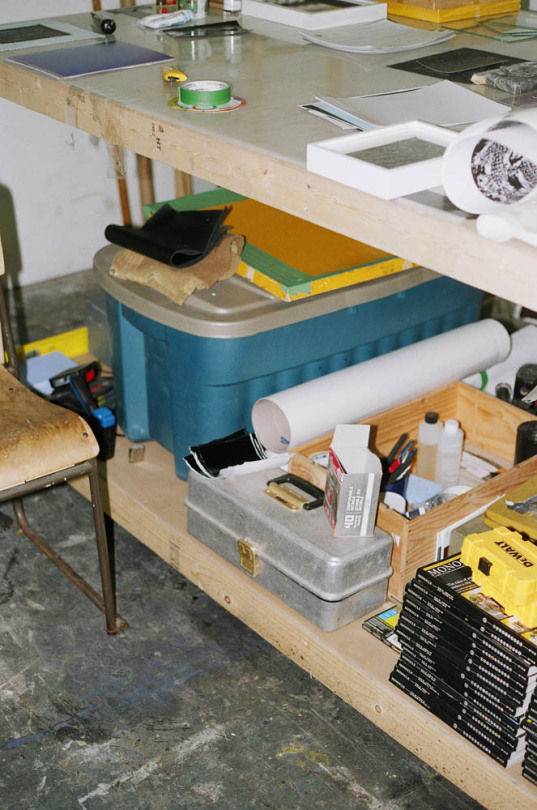
Wanda: Do you see a change in your work when you’re working in a studio alone versus with a lot of people?
Jérôme: I couldn’t really do it with a lot of people like let's say right now I’m working on a lot of different stuff at the same time so there’s a lot of stuff that’s not resolved and I don’t necessarily want people to see that. And it’s where having the gallery is a little inconvenient because if there’s a vernissage we’ll do a bar here and it’s open so I have to clean. I don’t want this stuff around that I don’t want people to see. But then again I could decide to leave it closed but I don’t really mind that. I think it’s actually something that’s a good exercise, knowing that some people are coming over. Like if you’re having a studio visit you can pull some stuff out. Especially when you’re in the process of making your work, to look at all your work. It informs you And the way I work, I try not to work series even though it’s really difficult especially when it comes time to mount a show and propose a show. To dig in a whole lot of different processes and see how they talk to each other. And that, to follow back to what you were saying about music, that’s where I find a link. Especially with DJ’ing and mixing. There’s a whole lot of digging and using things that you couldn’t really see together and when you put them together there’s this dialog that opens and goes beyond the individual work that starts to speak. That’s something that I like, it’s not really something that you can see and just sit down and say oh I’m going to do that. Sometimes it’s just by chance, I’ll be pulling stuff out from boxes and then I look at them and say “oh my god!”. It could be formally or in the content or me and how I see it, but there’s a connection happening. That’s something that I really like and try to do and so when people do come over it’s a chance to do that and rearrange and look at your work in a different way.
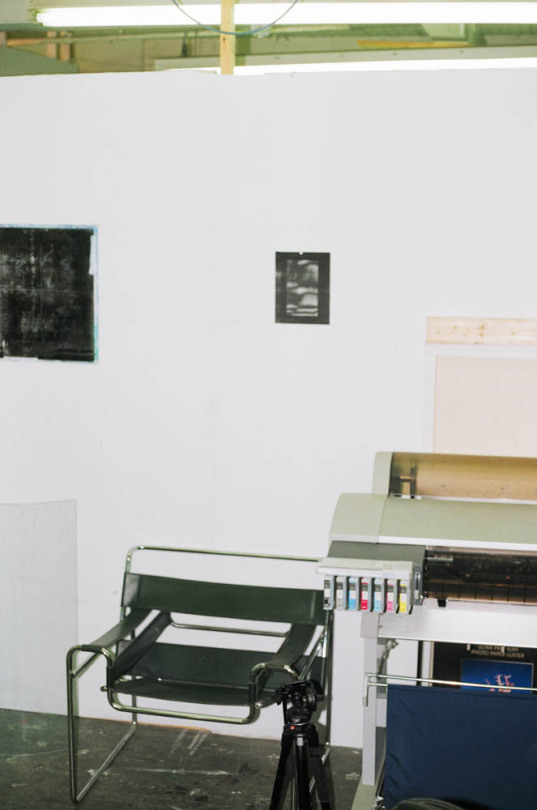
William: Since you’ve already built and organised a studio, is there anything that you would warn against to anyone building their own studio or just general advice?
Jérôme: I guess it depends what you want to do. I guess build clever storage. Here we’re pretty lucky because it’s outside the studio but I feel before we had built that storage space I had accumulated stuff from Concordia, from the studio I had at my house, the studio I had on Van Horne so there was stuff that would pile up and it’s nice to be able to have storage. But then again I would advise against keeping too much stuff. I feel that again with the studio visit it helps to at least once or twice a year to do a cleanup. Go around the studio and get rid of stuff, it’s important to keep some because you’ll never know what you’re going to need but personally I feel I tend to hold onto things for too long and it just weighs on you. So it’s nice to clean everything out and get a fresh start. Which is something that if you go on a residency like when I went to Sweden I don’t have a studio I have nothing at this point. So you can very easily restart and you’re not starting from nothing you still have all these ideas and everything you’ve previously done that’s in your mind. That’s usually where it starts and you can start to experiment with new material and new ideas and I feel it’s nice to provoke that sometimes. Like I’ve rebuilt the table this summer and I completely emptied everything out and took everything out of the storage right after a show where there was tons of accumulation of images and tests. And I decided to move over that I was done, time for a new chapter. So yeah, be organised with the way you’re putting stuff in storage because oh someone wants to see a piece they saw online and you want to rework on it and you go and try to find it and it’s in a box that isn’t labelled. It’s quite a nightmare sometimes.
William: Is there anything in here that if you had absolute omniscient power to change anything in the room, what would be the one thing you would get rid of, add?
Jérôme: Repaint the wall and plaster everything. Especially because it’s years and years of oil paint. If I could sand it all out. And while I don’t mind the floor being dirty it’s just that it’s not sealed and has so much dust stuck to it so I would fix that. Maybe the ceiling too, make it more soundproof. We’re pretty lucky now it’s quiet I don’t know what’s happening maybe they’re freaking out because they know the building just got sold. I don’t know what they do but they I feel like they always have these I think it’s clothing racks moving and it’s almost scary. Probably why I’m listening to music so loud all the time but sometimes it’s annoying.
Wanda: Do you personally feel as though you work better in situations of controlled chaos or very tidy?
Jérôme: It’s a mix in between, like Étienne that had this other part of the space, have you seen Francis Bacon’s studio? It was exactly like that. A mountain of fucking shit he bought from Dollarama and just complete mayhem. So you know when you look at my studio compared to that it was the most organized thing in the world. But it’s always a play between resetting everything. Everything is organized and cleaned up but I need stuff laying around to play with and remind myself. So it’s cyclical. I would say I’m quite organized but I’m not insane about it.
William: Yeah you’re not like Georgia O’Keefe levels.
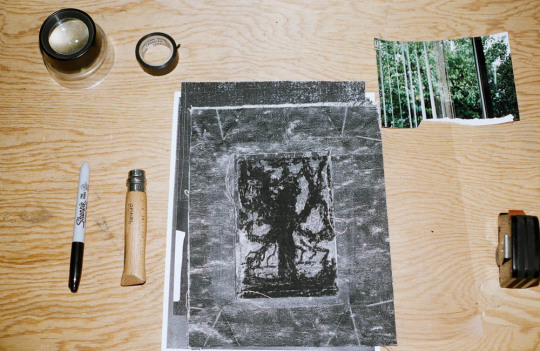
Jérôme: Yeah exactly, I wish I was like that. I’m like that in my house but here, maybe if I had a bigger space I could do that and I’d have a clean area. An area for printing and an area for experimenting with other materials and dirty practices. So I feel I could do that. Have an area that’s restricted by different processes.
William: What do you use most often in your studio?
Jérôme: I mean computer I guess but I wish it wasn’t that answer.
Wanda: So how long did it take to get the studio you wanted it to be or are you still evolving it?
Jérôme: It’s changed a lot. Like we built the wall a year and a half ago. So that changed a lot. When I got the printer I changed a lot of the configuration. I mean I’ve accumulated a lot of stuff. There’s also a moment where I was living in this really large apartment and I moved out so there was a lot of stuff like books that I had at my place that I moved here or in the storage. But I feel like it’s been like this since the summer, like I said I rebuilt the table so I built this platform underneath that works as storage. So it feels like it’s constantly changing.
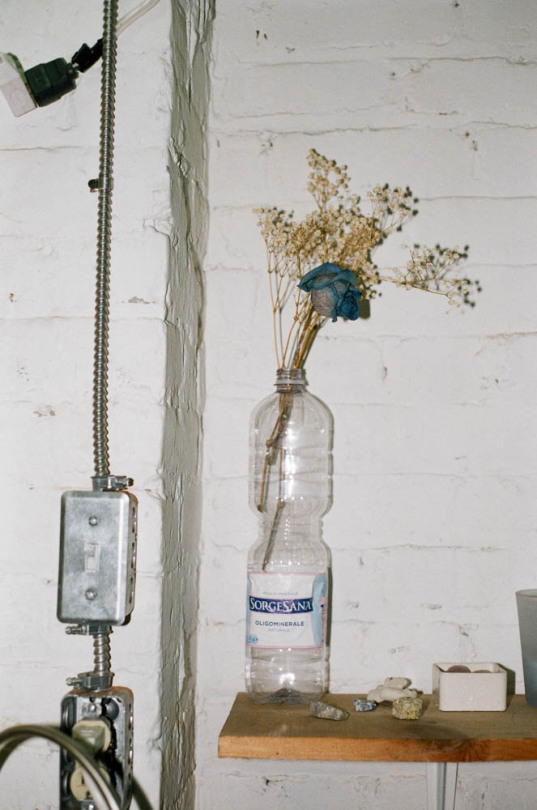
Wanda: Did you have any inspirations when building it? If so who were your inspirations?
Jérôme: No, I mean it was about practicality. Stuff that I found. Nothing really belongs to me here. Like there’s some wood panels that I found and this someone gave to me [legs for desk], and there were so many ex tenants that left wood that I used to build. Lot of finding stuff. Even the table I mean most simple studio table you can build for cheap. If I could build the ideal studio I guess the inspiration would be Donald Judd’s studio in New York and Marfa. He even left instructions when he died like the little rock there and the pen. He was a collector and has all these books, built everything and designed everything himself. If I had more space I wish I could do that. Even here doing renovation, you start cutting wood and there’s wood chip everywhere.
William: And the into the floors must be a nightmare.
Jérôme: Yeah if I do that there’s also the other studio so it’s a bit difficult. We’ve been through quite a bit of renovation. Painting the walls and rebuilding the whole gallery space about two years ago.
William: Universally, what do you think is a must for any studio? Like one thing that every artist should need.
Jérôme: An exact-o knife.
William: And what do you use yours for?
Jérôme: For everything. I don’t know. Not that I’m dealing with collage but like if you need to cut a piece of paper. Mine was lost for awhile, I left it in my friends car-
William: And you were lost without your exact-o knife?
Jérôme: Yeah and it was a really good one with the black blade that I paid thirty dollars for. And he said like “oh I have the same I kept it” and he never gave it back to me now that I think about it. I feel like it’s the thing that especially after realising that it was gone for awhile.
William: You don’t know what you have until you lose it?
Jérôme: Yeah. Yeah. So I guess that and headphones.
Wanda: Do you find yourself stressed when you’re working here or do you find that it relaxes you?
Jérôme: I don’t think the studio informs that, it’s more about what I have to work on or if I have a deadline.
William: Is there a part of the process that you dislike or like more than another one then?
Jérôme: Not really. I like starting a new project because usually you have more time and it’s easier to place your ideas and there’s this playfulness. But I also really like the last stretches, putting up a show and deciding. Having people over looking at your work and seeing what you’re going to present and doing studio visits that are really directed towards what you’re going to show. I really enjoy that when everything is done. Like I was saying when I was doing my MFA I was working with my teacher and adviser a lot. I would just bring boxes and boxes of work that I had done throughout the year on her table and we would play with it. So I like that. And I try when I’m working to not overthink it. I just get it out. Work and experiment, get stuff out. And then when I’ve accumulated enough and I find something that makes sense I can take a step back. Start to think about it, see how it situates with ideas and theory and see if it makes sense. If there’s anything happening between the works.

William: So then is there a prevailing emotion when you’re in here or is it really just based on what you’re currently working on then?
Jérôme: I guess it really changed throughout the years. Like at some point I moved out and I was I was in this weird thing where I didn’t have anywhere to stay. It was just a lot of change in my life. So the studio became this place where I was here everyday. I would just work a few nights a week. I was just here all the time so I think it was not really good because it just became my second house. Like I would come here even though I didn’t really have any shows planned. Work on the computer, make some tests, and then Jean-François would be here and we would just hang out and there was the gallery so I wasn’t really coming here to work. But again I feel like it’s sometimes good to be in the studio all the time. I kind of miss it. Like sometimes I would put that on myself. Like this summer it was insanely, insanely hot in here. It was unbearable so there was this whole month after a show where I told myself I can’t be in here. I’m forcing myself not to be in here. Because sometimes you want to work on something but you know you’re not in the right state of mind and work for nothing. So it was nice to miss it and when I came back and put everything in order I felt this renewed energy from me not being here everyday for a whole month when it was 45 degrees.

William: Did you work outside of your space during that month?
Jérôme: No I just read, researched, and prepared the class for Concordia and thinking of the facilities there. So how I could work there. So it was more like making lists of things I wanted to do with those facilities, knowing that I would be here and that I’d have access to a lot of stuff I didn’t have access to before.
William: Do you think then that it’s important to sometimes take a step back away from your studio space and organize your thoughts?
Jérôme: Yeah for sure. Since it’s hard for you to do that when you’re in the space working. So it’s nice to impose that on yourself as a constraint.
Wanda: Do you have any recommendations then for people who can’t afford to have a separate studio? Like a lot of the times they end having a living room or in their bedroom, do you have any advice?
Jérôme: Yeah I’ve done that for a long time and it’s personal. I know a lot of people love to have their studio in their space. With the winters it’s more convenient. I like the idea of going to work but I know it’s a lot of money and not only that you have to find a studio not too far from your house. Who you want to be with, who are you going to be sharing with? So there’s all these questions. Like mine was in my room for awhile… that I would not recommend except you can’t have it anywhere else. It’s nice to keep your room for sleeping, it’s healthier that way. But then I had this dining room that after a year we made diner and invited people once so I’m taking it over and I was paying extra and my roommate had a bigger room so it was this common agreement we had. It just made sense and it doesn’t have to be big it just has to-
William: Be somewhere to be productive in that space?
Jérôme: Yeah and your stuff is there and you know that when you go there you go there to work it’s not like you’re working from your couch or your bed. I even do that for writing like I can’t write in here.
William: Because it’s more visual?
Jérôme: It’s more visual, like I always want to work on something else when I’m here like I look and there’s all these ideas and I need to be in a neutral space. Like the library is good for that, in my house I set up a space where I write so it’s nice when you have a space dedicated-
William: For specific tasks?
Jérôme: Yeah specific tasks, function. When you go there it feels like your mind is already settling into that mode. Even reading like I don’t see the point in coming here to read, I’ll go to the library, a cafe, or outside if I can.
Though actually if I could change something about the studio I wish there was more space where we could do this and be more comfortable. Have people over. I know Marc Seguin would invite people over all the time; collectors, curators, friends-
William: Have almost like a social space, like an old coffee house type of thing.
Jérôme: Yeah and again with Jean-François it was always like that. End of our day and just have a beer so you hang out and it’s nice when you have the chance to do that. Have conversations and talk about your work.
William: So you think it’s important to be able to have that social aspect?
Jérôme: Yeah I guess it’s really personal but I feel like, I give meetings with people here and most of the time it’s convenient because I’m here working. It’s another reason why having a studio outside of your house is nice because I had studio visits at people's house and you like judge everything it’s not comfortable for the other person for like an hour just standing there in someone's house. So it’s nice when ok you look at peoples work but you can sit down and relax, talk. But yeah it’d be nice if the space could function like that. Because collectors and curators you’ll have studio visits like so to be able to make the space as nice as possible would be cool. Also makes it go for longer.
William: Like ow my legs are hurting
Jérôme: Yeah and the chair is full of paint and you don’t want to touch anything. But then again some people might like it if you go to place and it’s just mountains of shit laying around and work.
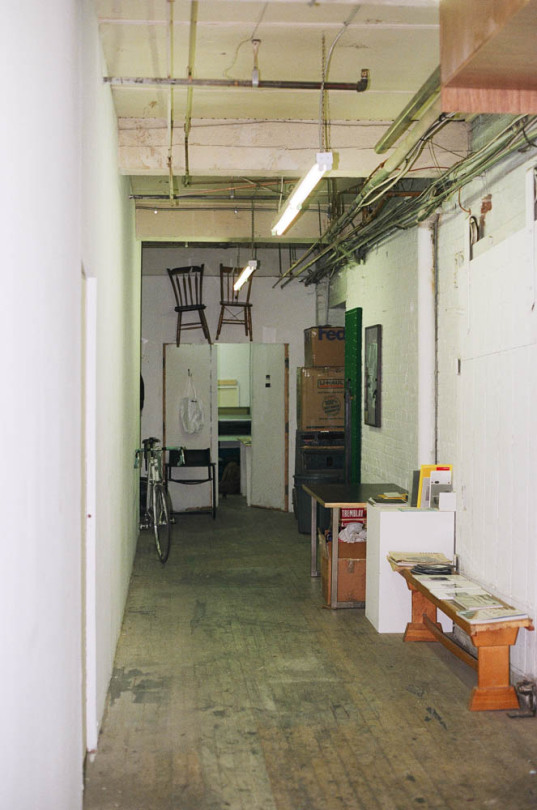
William: I mean personally I wouldn’t want to go to Francis Bacon’s studio. That place looked insane.
Wanda: I would love to go like you’ve seen my room I wouldn’t be too upset.
William: Yeah but can you imagine doing a studio visit there just standing there for hours?
Wanda: Yeah can I move this pile of trash to this side of the room for one second!
William: It’s not trash, needs to be right there!
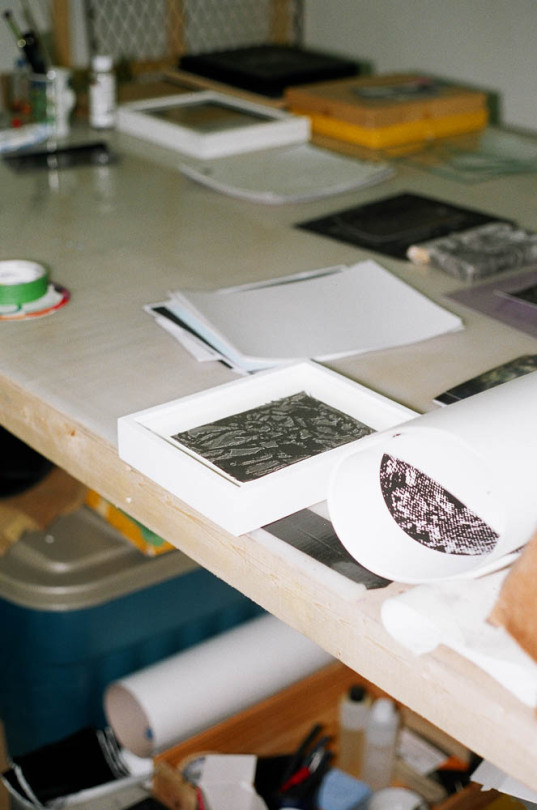
#artresidency#artistseries#montreal#montrealart#artstudio#artistspace#artist interview#interview#film photography#photographer interview#canadian art#quebec art#concordia university#concordia
2 notes
·
View notes
Link
Another great Abstract Expressionist, totally different from DeFeo. Amazing use of colours.
She said of her work, “That particular thing I want can’t be verbalized. . . . I’m trying for something more specific than movies of my everyday life: To define a feeling.” “She could make yellow heavy,” Brice Marden later mused of her uncanny ability to infuse her paintings with mood.
Taken from MoMa website: https://www.moma.org/artists/4026
0 notes
Text
Fondé au milieu du XIX siècle, ce Musée comprend cinq pavillons de part en d’autres de la rue Sherbrooke Ouest et sont reliés par des passages souterrains. L’endroit où l’on prend les billets est le Pavillon Jean-Noël Desmarais, œuvre d’une grande modernité.
Comme ce musée présente un résumé de l’art mondial, il est bien évident qu’on ne peut l’appréhender dans son ensemble au cours d’un séjour bref.
Lorsque nous l’avons visité, Picasso primitif était l’exposition temporaire phare que nous avions visité à Paris il y a 2 ans.
Ce mini -Louvre présente un résumé de l’art mondial à travers les siècles et les collections permanentes.
Nous avons choisi de se “limiter” à l’Art québecois et canadien et aux Arts décoratifs et Design.
Art québecois et canadien
Ce pavillon, appelé Pavillon Claire et Marc Bourgie, est composé d’une ancienne église et d’un bâtiment moderne. Ce panorama démarre au 4ème étage pour se poursuivre jusqu’au RDC. Impossible donc de donner une vision générale, aussi, je limiterai la présentation à mes coups de cœur !
Os de baleine- Andrew Innuklun – 1971 – Art contemporain Inuit
Casque à cimier-Le corbeau, créateur et bienfaiteur de l’humanité chevauche un poisson évidé est un casque en bois que le danseur porte au cérémonie rituelle.
Masque représentant une grousse (oiseau)
A l’ombre de la treille – Helen Gallaway Mc Nicoll – 1914
Ça ressemble à …. Normal ! Helen Gallaway Mc Nicoll est LE peintre impressionniste au Canada qui a séjourné en France.
Couple de caribou de Shorty Killiktee, sculpteur contemporain Inuit
L’emprise de la pensée – Alfred Laliberté-
Pareil … Normal, Alfred Laliberté est venu étudier à Paris, notamment dans l’atelier de Rodin. Mais, là encore c’est LE sculpteur québecois.
Saint Siméon Marc-Aurèle Fortin – 1938
“Le prolifique Marc-Aurèle Fortin a été peintre, aquarelliste, graveur et dessinateur et ses paysages très décoratifs et colorés mettent en valeur l´aspect pittoresque de la nature. Parmi ses sujets préférés, mentionnons d´énormes ormes feuillus, des maisons rustiques, des charrettes de foin et le port de Montréal; ses rares sujets humains semblent habituellement écrasés par la nature. Sur le plan technique, Fortin était inventif, expérimentant à l´aide de différentes méthodes d´aquarelle, de peinture à l´huile et de techniques mixtes”. Musée des Beaux-Arts du Canada
Mais, l’enfant du pays des temps modernes, c’est Jean-Paul Riopelle. Rendez-vous compte, bien avant l’exposition universelle à Montréal qui a eu lieu en 1967 et qui a fait connaître la ville et la province du Québec au monde entier, Jean-François Riopelle a exporté ce pays dans ses recherches picturales lorsque New-York a compté dans l’Art international.
“Jean-Paul Riopelle est un expressionniste abstrait canadien surtout connu pour ses paysages non figuratifs. Riopelle utilise de la peinture pressée directement du tube et appliquée librement à l’aide d’un couteau à palette pour élaborer des mosaïques denses et à grande échelle. Après un voyage à Paris en 1947, Riopelle devient l’un des membres de l’École de Paris, dont fait partie Joan Mitchell, avec laquelle il vit et travaille pendant près de 15 ans. ” Artnet
Vertige – Jean-Paul Riopelle 195
Gros plan
Gravité-1956
Autriche III – 1954
Soleil de minuit – Collection Iceberg- 1972/1978
Détails
Owl – 1979
Hibou II – 1970
Un autre enfant du pays et celui-ci exclusivement dans le domaine de la sculpture, c’est Louis Archambault (1915-2003), un grand artiste de l’art moderne.
Dame lunaire – 1992
L’oiseau lunaire -1954
Et, je terminerais par ce tableau pour témoigner de la richesse de la création au Québec.
Jardin rouge – Alfred Pellan – 1958
Questions pratiques:
Musée des beaux arts Montréal
1380, rue Sherbrooke Ouest Pavillon Jean-Noël Desmarais
Visite d'une partie du Musée des Beaux-Arts à Montréal. Art québecois et canadien Voir « à la place de » pour donner envie Fondé au milieu du XIX siècle, ce Musée comprend cinq pavillons de part en d'autres de la rue Sherbrooke Ouest et sont reliés par des passages souterrains.
#art#Art américain#Art canadien#Art québecois#Beaux Arts#Billet de voyage#Canada#Chronique de voyage#Histoire de l&039;art#MBAM#Montréal#Musée des Beaux-Arts Montréal#MUSEE#Musee des Beaux Arts#music#Peintures#Peintures inuit#Peintures modernes#Québec#Sculptures#Scultures canadiennes#VOYAGE
1 note
·
View note
Text
Soleil Rose

Photo: Bill OrcuttJoan Mitchell, Sans titre, 1951. Huile sur toile, 187,6 × 203,2 cm. Collection particulière, Paris © Estate of Joan Mitchell.
Tu Soleil rose Tu, quand tu marches entres Masse rose qui ne cesse vibre préside Tu poème soleil rose matin Tu chemin chemines dans Ne cesse cette courbe Sous tu soleil rose cette courbe sombre chemin Et si tu, si je ne vois pas ce que tu Tu, Joan Mitchell, Soleil Rose Soleil rose m’attire M’attire Tu Soleil rose ne veux être comparée à rien Soleil rose Très bien Je ne j’essaierai de ne pas à demi les yeux je ferme Comme appris Pour entre les paupières de la composition Faire sourdre l’âme Le coin, en bas, à droite Est léger est blanc Est prémisse de toutes tes toiles La légèreté des angles, des pourtours Tu, soleil rose, te concentre Concentre tes rayons Se répartisse tes masses chaudes Au haut petites et fragmentaires Au bas larges Comme larges flaques de soleil Rose rouge sur Je pense aux méplats Des plateaux hopis Inaccessibles invisibles Troglodytes Peut-on dire Ta peinture troglodyte Mitchell ? Peut-on dire qu’elle creuse la toile ta peinture Qu’elle absorbe tout Etoile lumineuse rose ou noire Vers le centre, tu centreras davantage Qu’elle absorbe et creuse troue Remonte jusqu’à cesser in finie
#mitchell#joan mitchell#mitchell riopelle#mitchell riopelle un couple dans la démesure#fhel#Landerneau#kawala
0 notes